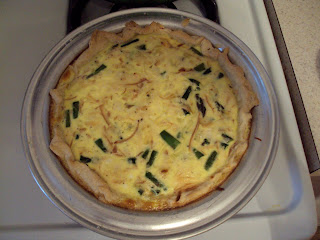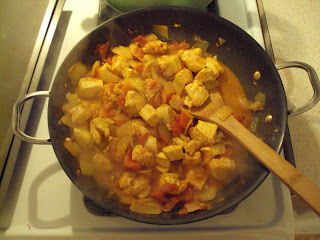 I am currently reading this book by Barbara Kingsolver. I've read a couple of her novels in the past, which are wonderful, but this book is a revelation. Or rather, it puts into words exactly how I feel about America's current food/health predicament and re-iterates the painfully simple solution, which happens to be the heart of this Lenten challenge.
I am currently reading this book by Barbara Kingsolver. I've read a couple of her novels in the past, which are wonderful, but this book is a revelation. Or rather, it puts into words exactly how I feel about America's current food/health predicament and re-iterates the painfully simple solution, which happens to be the heart of this Lenten challenge.The basic premise of the book is a journalistic account of her family's decision to abandon city life in Tuscon, AZ; move to a farm in Appalachia, and survive only on local food for an entire year, much of it grown on their own farm by their own two hands.
I find her prose remarkably humble, witty, and just so...true. Like Michael Pollan, she has obviously done lots of research on industrial food production and reports many of the same facts he touts in his books. But Kingsolver gets down into the heart of the matter in a way that Pollan never does in any of his books. Maybe it's because she's a woman charged with the task of feeding her family. Maybe it's because she came of age in an era when processed food was seen as a "gift" to women who wanted out of the house and into the workforce, much to our current demise. Maybe it's just that she's a damn good writer. Nevertheless, I find myself nodding my head vigorously at every chapter, and I just made my husband sit down so I could read him a 5 page excerpt. I'm not even halfway through the thing yet and already I want to get on the rooftops and shout to people "Read this book, it will change your life!".
This is where I get myself into trouble. I tend to get overzealous about sharing my feelings about cooking and food with others. But it's so easy, I tell myself. They should know too! I don't have a knack for humility like Kingsolver. At best, I come off sounding like a snooty, younger (and much thinner) version of Ina Garten. How easy is that?
It's so not my intention. And so I'm going to shut up now and let Barbara Kingsolver do the talking. This will the the first of a couple of installments of her writing that I'm planning to post here:
On the concept of organic/local food as an "elites-only" privilege:
"Even so, a perception of organic food as an elite privilege is a considerable obstacle to the farmer growing food for middle-income customers whose highest food-shopping priority is the lowest price. Raising food without polluting the field or the product will always cost more than the conventional mode that externalizes costs to taxpayers and the future...(she is speaking about the the tax dollars we pay that subsidize the petroleum used in growing, processing, and shipping industrially produced food, as well as the subsidies we pay to this large-scale, chemical dependent brand of farming, the amount of which is increasing each year, not to mention the toll on the environment and the depletion of resources for future generations).
She goes on to say: "Grocery money is an odd sticking point for U.S. citizens, who on average spend a lower proportion of our income on food than people in any other country, or heretofore in history. In our daily fare, even in school lunches, we broadly justify consumption of tallow-fried animal pulp on the grounds that it's cheaper than whole grains, fresh vegetables, hormone-free dairy, and such. Whether on school boards or in families, budget keepers may be aware of the health tradeoff but still feel compelled to economize on food - in a manner that would be utterly unacceptable if the health risk involved an unsafe family vehicle or a plume of benzene running through a school basement."
"It's interesting that penny-pinching is an accepted defense for toxic food habits, when frugality so rarely rules other consumer domains. The majority of Americans buy bottled drinking water, for example, even though water runs from the faucets at home for a fraction of the cost, and government quality standards are stricter for tap water than for bottled. At any income level, we can be relied upon for categorically unnecessary purchases: portable-earplug music instead of the radio; extra-fast Internet for leisure use; heavy vehicles to transport light loads; name brand clothing instead of plainer gear."
"How delusional are we, exactly? Insisting to farmers that our food has to be cheap is like commanding a ten-year-old to choose a profession and move out of the house now. It violates the spirit of the enterprise. It guarantees bad results. The economy of the arrangement will come around to haunt you..."
"...the 'Buy Cheap Eats' crusade is assisting in the deaths of our compatriots at the rate of about 820 a day; somebody's bound to notice that."
One more thought from me, Emily: My own grandfather died of obesity at age 65. They actually wrote "obesity" on his death certificate rather than "heart disease" or whatever else they could have written. He wasn't one of those gigantic people that you might stare at, but he probably wasn't comfortable in an airplane seat. I've begun to wonder just how many of our loved ones could have been saved, and who still could be saved - if our food system wasn't controlled by capitalism and an industry that sits around trying to figure out how to shove more corn byproducts into the American people. They literally have meetings like that, and they are succeeding. I think I'm justifiably angry.
The painfully simple truth I spoke about earlier is that we can beat all this, simply by finding the best foods (and by that I mean, whole, real foods) we can afford and cooking them. It can start today, with a meal, at your table, with the ones you love.


































